Analysis of Sustainable Tourism Development in Malaysia
VerifiedAdded on 2020/06/06
|12
|3880
|20
Report
AI Summary
This report provides a comprehensive analysis of sustainable tourism development in Malaysia. It begins by identifying the stakeholders involved in the tourism industry, including the government, tourism industry, local communities, and tourists, and examines the benefits each receives from tourism development planning. The report then explores the advantages and disadvantages of public-private sector partnerships in tourism planning. It further delves into the features of tourism development planning, interactive planning systems, and methods for measuring the impact of tourism. The concept of sustainability in tourism development is introduced, along with factors that hinder sustainable practices. The report also evaluates methods for resolving conflicts of interest, balancing demand and supply, and addressing ethical issues in enclave tourism. Finally, it compares current issues associated with tourism development and offers recommendations for the future development of tourism in Malaysia, emphasizing the importance of sustainable practices for long-term success. This report is an excellent resource for students studying tourism and related fields, offering insights into the challenges and opportunities within the Malaysian tourism sector.
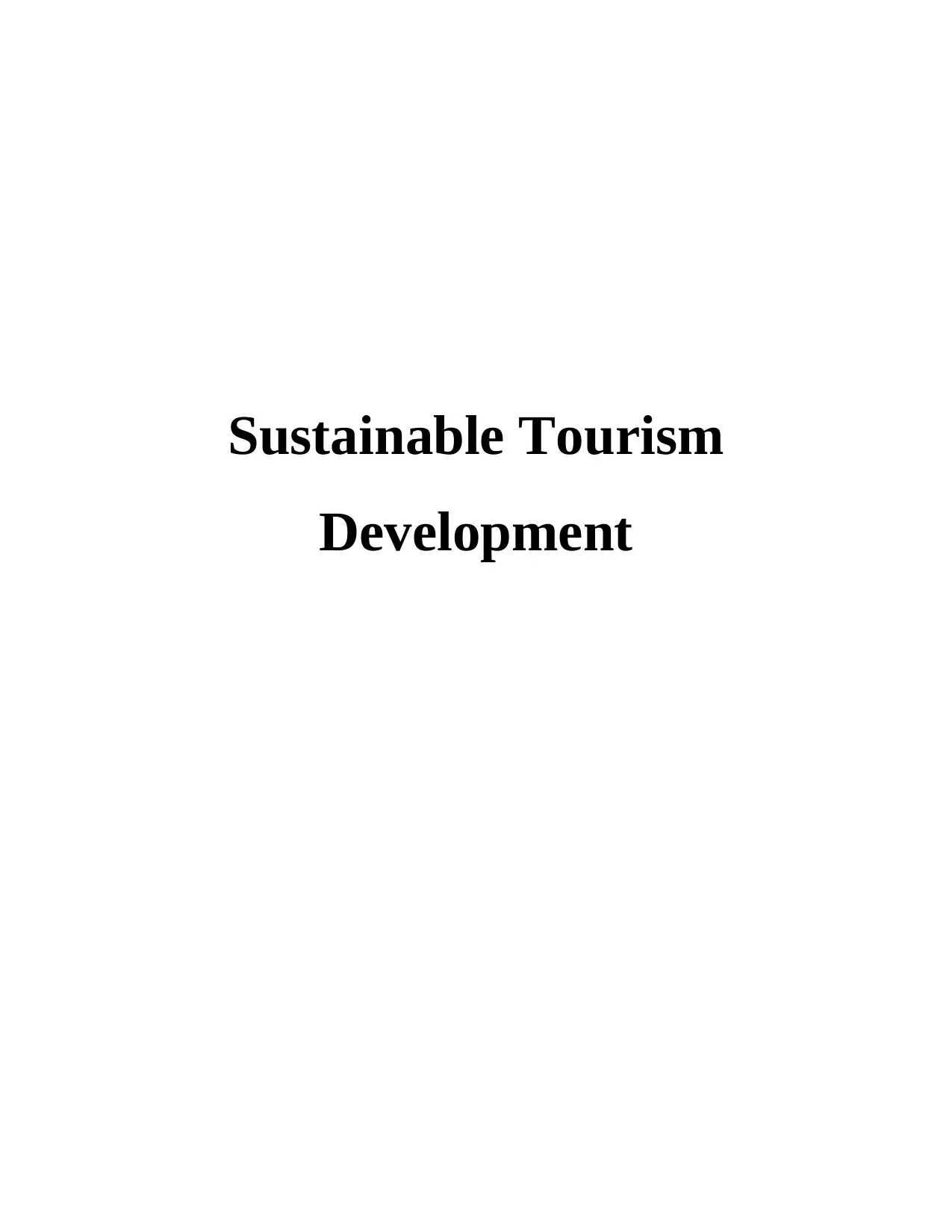
Sustainable Tourism
Development
Development
Paraphrase This Document
Need a fresh take? Get an instant paraphrase of this document with our AI Paraphraser
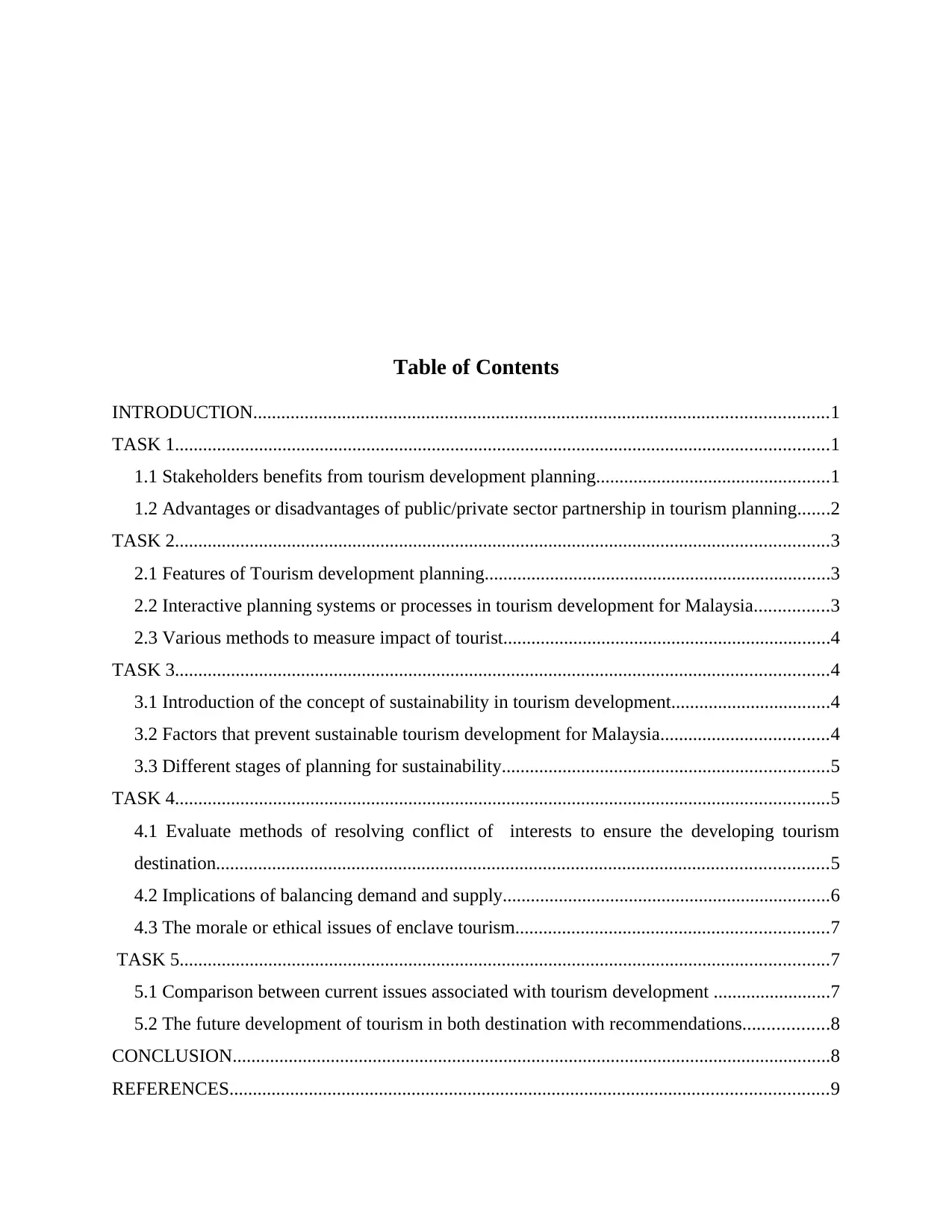
Table of Contents
INTRODUCTION...........................................................................................................................1
TASK 1............................................................................................................................................1
1.1 Stakeholders benefits from tourism development planning..................................................1
1.2 Advantages or disadvantages of public/private sector partnership in tourism planning.......2
TASK 2............................................................................................................................................3
2.1 Features of Tourism development planning..........................................................................3
2.2 Interactive planning systems or processes in tourism development for Malaysia................3
2.3 Various methods to measure impact of tourist......................................................................4
TASK 3............................................................................................................................................4
3.1 Introduction of the concept of sustainability in tourism development..................................4
3.2 Factors that prevent sustainable tourism development for Malaysia....................................4
3.3 Different stages of planning for sustainability......................................................................5
TASK 4............................................................................................................................................5
4.1 Evaluate methods of resolving conflict of interests to ensure the developing tourism
destination...................................................................................................................................5
4.2 Implications of balancing demand and supply......................................................................6
4.3 The morale or ethical issues of enclave tourism...................................................................7
TASK 5...........................................................................................................................................7
5.1 Comparison between current issues associated with tourism development .........................7
5.2 The future development of tourism in both destination with recommendations..................8
CONCLUSION................................................................................................................................8
REFERENCES................................................................................................................................9
INTRODUCTION...........................................................................................................................1
TASK 1............................................................................................................................................1
1.1 Stakeholders benefits from tourism development planning..................................................1
1.2 Advantages or disadvantages of public/private sector partnership in tourism planning.......2
TASK 2............................................................................................................................................3
2.1 Features of Tourism development planning..........................................................................3
2.2 Interactive planning systems or processes in tourism development for Malaysia................3
2.3 Various methods to measure impact of tourist......................................................................4
TASK 3............................................................................................................................................4
3.1 Introduction of the concept of sustainability in tourism development..................................4
3.2 Factors that prevent sustainable tourism development for Malaysia....................................4
3.3 Different stages of planning for sustainability......................................................................5
TASK 4............................................................................................................................................5
4.1 Evaluate methods of resolving conflict of interests to ensure the developing tourism
destination...................................................................................................................................5
4.2 Implications of balancing demand and supply......................................................................6
4.3 The morale or ethical issues of enclave tourism...................................................................7
TASK 5...........................................................................................................................................7
5.1 Comparison between current issues associated with tourism development .........................7
5.2 The future development of tourism in both destination with recommendations..................8
CONCLUSION................................................................................................................................8
REFERENCES................................................................................................................................9
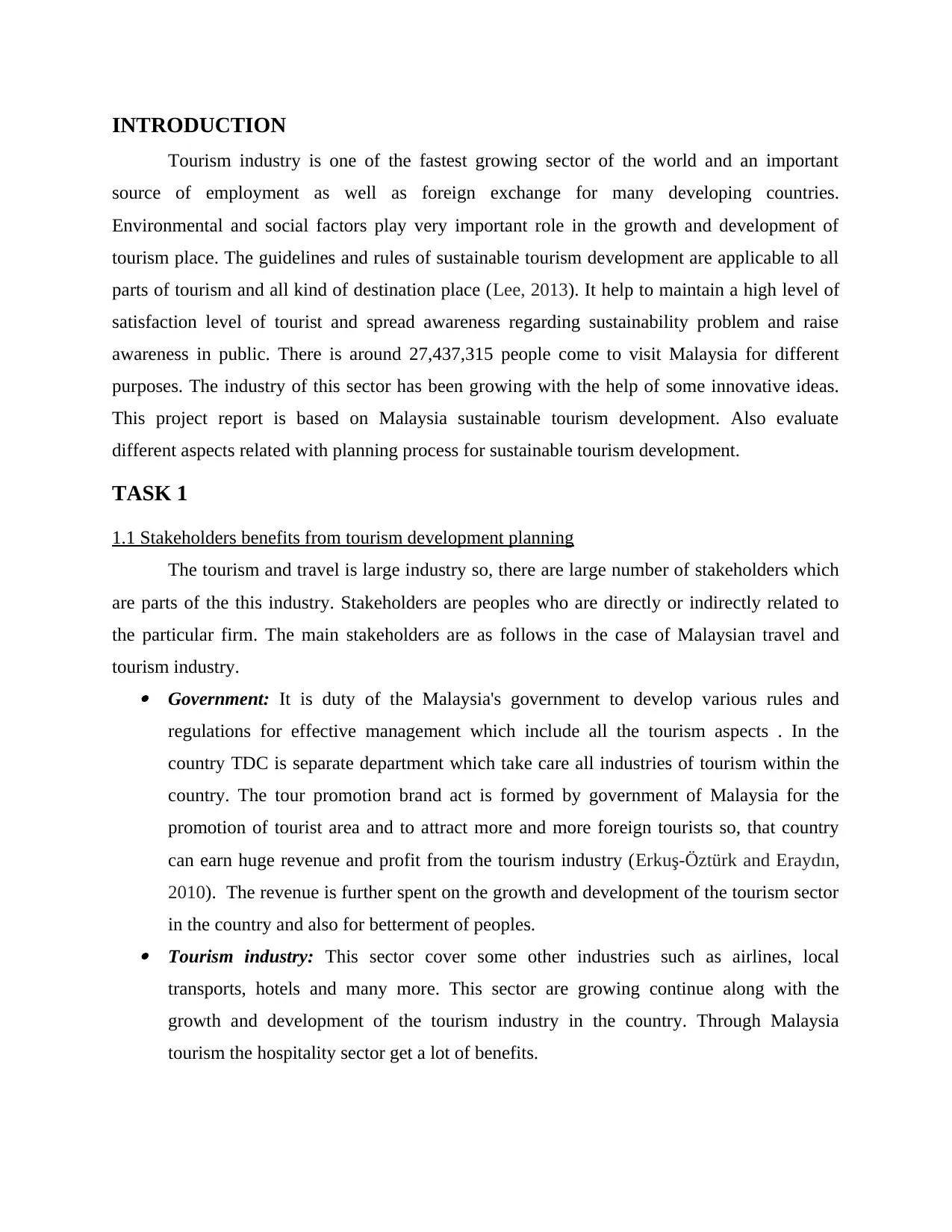
INTRODUCTION
Tourism industry is one of the fastest growing sector of the world and an important
source of employment as well as foreign exchange for many developing countries.
Environmental and social factors play very important role in the growth and development of
tourism place. The guidelines and rules of sustainable tourism development are applicable to all
parts of tourism and all kind of destination place (Lee, 2013). It help to maintain a high level of
satisfaction level of tourist and spread awareness regarding sustainability problem and raise
awareness in public. There is around 27,437,315 people come to visit Malaysia for different
purposes. The industry of this sector has been growing with the help of some innovative ideas.
This project report is based on Malaysia sustainable tourism development. Also evaluate
different aspects related with planning process for sustainable tourism development.
TASK 1
1.1 Stakeholders benefits from tourism development planning
The tourism and travel is large industry so, there are large number of stakeholders which
are parts of the this industry. Stakeholders are peoples who are directly or indirectly related to
the particular firm. The main stakeholders are as follows in the case of Malaysian travel and
tourism industry. Government: It is duty of the Malaysia's government to develop various rules and
regulations for effective management which include all the tourism aspects . In the
country TDC is separate department which take care all industries of tourism within the
country. The tour promotion brand act is formed by government of Malaysia for the
promotion of tourist area and to attract more and more foreign tourists so, that country
can earn huge revenue and profit from the tourism industry (Erkuş-Öztürk and Eraydın,
2010). The revenue is further spent on the growth and development of the tourism sector
in the country and also for betterment of peoples. Tourism industry: This sector cover some other industries such as airlines, local
transports, hotels and many more. This sector are growing continue along with the
growth and development of the tourism industry in the country. Through Malaysia
tourism the hospitality sector get a lot of benefits.
Tourism industry is one of the fastest growing sector of the world and an important
source of employment as well as foreign exchange for many developing countries.
Environmental and social factors play very important role in the growth and development of
tourism place. The guidelines and rules of sustainable tourism development are applicable to all
parts of tourism and all kind of destination place (Lee, 2013). It help to maintain a high level of
satisfaction level of tourist and spread awareness regarding sustainability problem and raise
awareness in public. There is around 27,437,315 people come to visit Malaysia for different
purposes. The industry of this sector has been growing with the help of some innovative ideas.
This project report is based on Malaysia sustainable tourism development. Also evaluate
different aspects related with planning process for sustainable tourism development.
TASK 1
1.1 Stakeholders benefits from tourism development planning
The tourism and travel is large industry so, there are large number of stakeholders which
are parts of the this industry. Stakeholders are peoples who are directly or indirectly related to
the particular firm. The main stakeholders are as follows in the case of Malaysian travel and
tourism industry. Government: It is duty of the Malaysia's government to develop various rules and
regulations for effective management which include all the tourism aspects . In the
country TDC is separate department which take care all industries of tourism within the
country. The tour promotion brand act is formed by government of Malaysia for the
promotion of tourist area and to attract more and more foreign tourists so, that country
can earn huge revenue and profit from the tourism industry (Erkuş-Öztürk and Eraydın,
2010). The revenue is further spent on the growth and development of the tourism sector
in the country and also for betterment of peoples. Tourism industry: This sector cover some other industries such as airlines, local
transports, hotels and many more. This sector are growing continue along with the
growth and development of the tourism industry in the country. Through Malaysia
tourism the hospitality sector get a lot of benefits.
⊘ This is a preview!⊘
Do you want full access?
Subscribe today to unlock all pages.

Trusted by 1+ million students worldwide
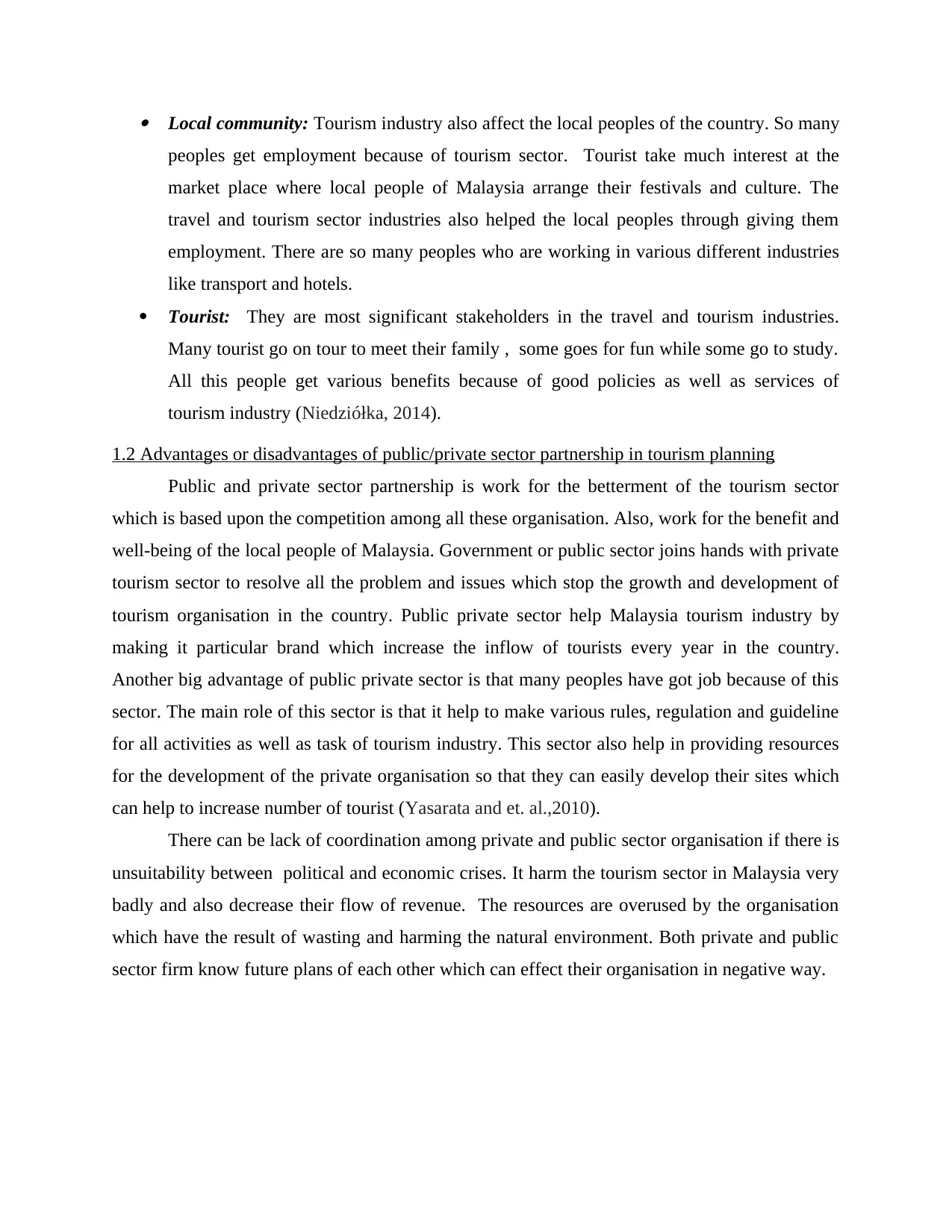
Local community: Tourism industry also affect the local peoples of the country. So many
peoples get employment because of tourism sector. Tourist take much interest at the
market place where local people of Malaysia arrange their festivals and culture. The
travel and tourism sector industries also helped the local peoples through giving them
employment. There are so many peoples who are working in various different industries
like transport and hotels.
Tourist: They are most significant stakeholders in the travel and tourism industries.
Many tourist go on tour to meet their family , some goes for fun while some go to study.
All this people get various benefits because of good policies as well as services of
tourism industry (Niedziółka, 2014).
1.2 Advantages or disadvantages of public/private sector partnership in tourism planning
Public and private sector partnership is work for the betterment of the tourism sector
which is based upon the competition among all these organisation. Also, work for the benefit and
well-being of the local people of Malaysia. Government or public sector joins hands with private
tourism sector to resolve all the problem and issues which stop the growth and development of
tourism organisation in the country. Public private sector help Malaysia tourism industry by
making it particular brand which increase the inflow of tourists every year in the country.
Another big advantage of public private sector is that many peoples have got job because of this
sector. The main role of this sector is that it help to make various rules, regulation and guideline
for all activities as well as task of tourism industry. This sector also help in providing resources
for the development of the private organisation so that they can easily develop their sites which
can help to increase number of tourist (Yasarata and et. al.,2010).
There can be lack of coordination among private and public sector organisation if there is
unsuitability between political and economic crises. It harm the tourism sector in Malaysia very
badly and also decrease their flow of revenue. The resources are overused by the organisation
which have the result of wasting and harming the natural environment. Both private and public
sector firm know future plans of each other which can effect their organisation in negative way.
peoples get employment because of tourism sector. Tourist take much interest at the
market place where local people of Malaysia arrange their festivals and culture. The
travel and tourism sector industries also helped the local peoples through giving them
employment. There are so many peoples who are working in various different industries
like transport and hotels.
Tourist: They are most significant stakeholders in the travel and tourism industries.
Many tourist go on tour to meet their family , some goes for fun while some go to study.
All this people get various benefits because of good policies as well as services of
tourism industry (Niedziółka, 2014).
1.2 Advantages or disadvantages of public/private sector partnership in tourism planning
Public and private sector partnership is work for the betterment of the tourism sector
which is based upon the competition among all these organisation. Also, work for the benefit and
well-being of the local people of Malaysia. Government or public sector joins hands with private
tourism sector to resolve all the problem and issues which stop the growth and development of
tourism organisation in the country. Public private sector help Malaysia tourism industry by
making it particular brand which increase the inflow of tourists every year in the country.
Another big advantage of public private sector is that many peoples have got job because of this
sector. The main role of this sector is that it help to make various rules, regulation and guideline
for all activities as well as task of tourism industry. This sector also help in providing resources
for the development of the private organisation so that they can easily develop their sites which
can help to increase number of tourist (Yasarata and et. al.,2010).
There can be lack of coordination among private and public sector organisation if there is
unsuitability between political and economic crises. It harm the tourism sector in Malaysia very
badly and also decrease their flow of revenue. The resources are overused by the organisation
which have the result of wasting and harming the natural environment. Both private and public
sector firm know future plans of each other which can effect their organisation in negative way.
Paraphrase This Document
Need a fresh take? Get an instant paraphrase of this document with our AI Paraphraser
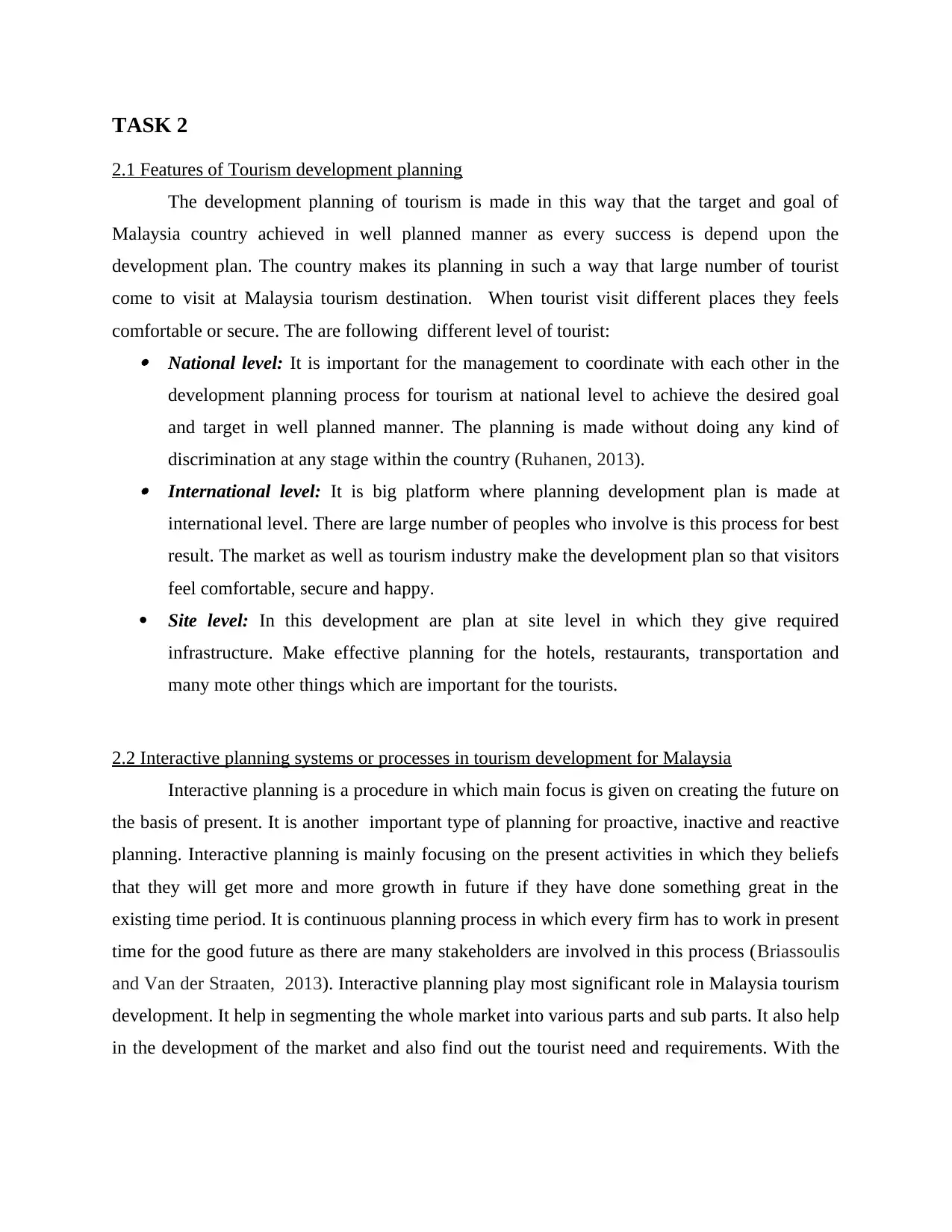
TASK 2
2.1 Features of Tourism development planning
The development planning of tourism is made in this way that the target and goal of
Malaysia country achieved in well planned manner as every success is depend upon the
development plan. The country makes its planning in such a way that large number of tourist
come to visit at Malaysia tourism destination. When tourist visit different places they feels
comfortable or secure. The are following different level of tourist: National level: It is important for the management to coordinate with each other in the
development planning process for tourism at national level to achieve the desired goal
and target in well planned manner. The planning is made without doing any kind of
discrimination at any stage within the country (Ruhanen, 2013). International level: It is big platform where planning development plan is made at
international level. There are large number of peoples who involve is this process for best
result. The market as well as tourism industry make the development plan so that visitors
feel comfortable, secure and happy.
Site level: In this development are plan at site level in which they give required
infrastructure. Make effective planning for the hotels, restaurants, transportation and
many mote other things which are important for the tourists.
2.2 Interactive planning systems or processes in tourism development for Malaysia
Interactive planning is a procedure in which main focus is given on creating the future on
the basis of present. It is another important type of planning for proactive, inactive and reactive
planning. Interactive planning is mainly focusing on the present activities in which they beliefs
that they will get more and more growth in future if they have done something great in the
existing time period. It is continuous planning process in which every firm has to work in present
time for the good future as there are many stakeholders are involved in this process (Briassoulis
and Van der Straaten, 2013). Interactive planning play most significant role in Malaysia tourism
development. It help in segmenting the whole market into various parts and sub parts. It also help
in the development of the market and also find out the tourist need and requirements. With the
2.1 Features of Tourism development planning
The development planning of tourism is made in this way that the target and goal of
Malaysia country achieved in well planned manner as every success is depend upon the
development plan. The country makes its planning in such a way that large number of tourist
come to visit at Malaysia tourism destination. When tourist visit different places they feels
comfortable or secure. The are following different level of tourist: National level: It is important for the management to coordinate with each other in the
development planning process for tourism at national level to achieve the desired goal
and target in well planned manner. The planning is made without doing any kind of
discrimination at any stage within the country (Ruhanen, 2013). International level: It is big platform where planning development plan is made at
international level. There are large number of peoples who involve is this process for best
result. The market as well as tourism industry make the development plan so that visitors
feel comfortable, secure and happy.
Site level: In this development are plan at site level in which they give required
infrastructure. Make effective planning for the hotels, restaurants, transportation and
many mote other things which are important for the tourists.
2.2 Interactive planning systems or processes in tourism development for Malaysia
Interactive planning is a procedure in which main focus is given on creating the future on
the basis of present. It is another important type of planning for proactive, inactive and reactive
planning. Interactive planning is mainly focusing on the present activities in which they beliefs
that they will get more and more growth in future if they have done something great in the
existing time period. It is continuous planning process in which every firm has to work in present
time for the good future as there are many stakeholders are involved in this process (Briassoulis
and Van der Straaten, 2013). Interactive planning play most significant role in Malaysia tourism
development. It help in segmenting the whole market into various parts and sub parts. It also help
in the development of the market and also find out the tourist need and requirements. With the
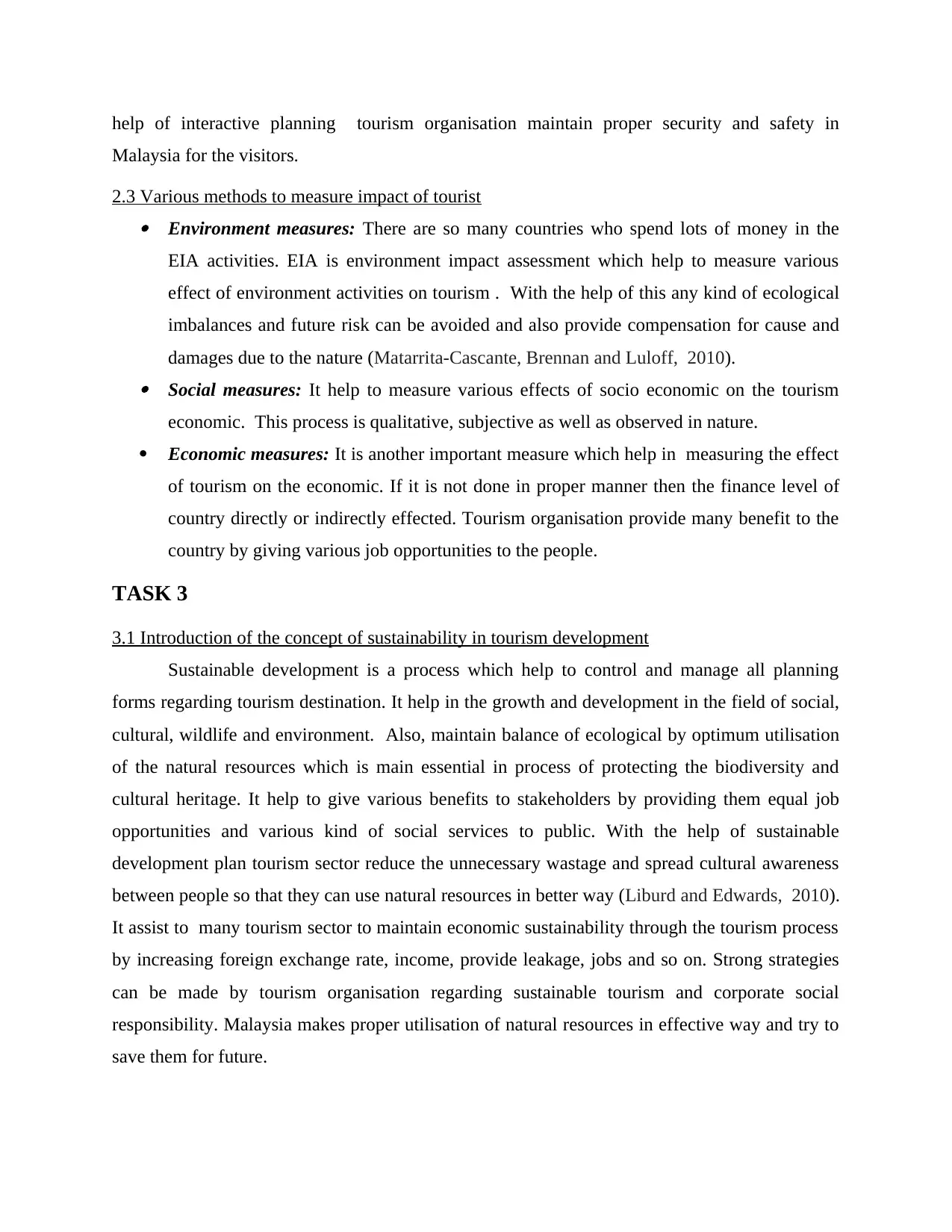
help of interactive planning tourism organisation maintain proper security and safety in
Malaysia for the visitors.
2.3 Various methods to measure impact of tourist Environment measures: There are so many countries who spend lots of money in the
EIA activities. EIA is environment impact assessment which help to measure various
effect of environment activities on tourism . With the help of this any kind of ecological
imbalances and future risk can be avoided and also provide compensation for cause and
damages due to the nature (Matarrita-Cascante, Brennan and Luloff, 2010). Social measures: It help to measure various effects of socio economic on the tourism
economic. This process is qualitative, subjective as well as observed in nature.
Economic measures: It is another important measure which help in measuring the effect
of tourism on the economic. If it is not done in proper manner then the finance level of
country directly or indirectly effected. Tourism organisation provide many benefit to the
country by giving various job opportunities to the people.
TASK 3
3.1 Introduction of the concept of sustainability in tourism development
Sustainable development is a process which help to control and manage all planning
forms regarding tourism destination. It help in the growth and development in the field of social,
cultural, wildlife and environment. Also, maintain balance of ecological by optimum utilisation
of the natural resources which is main essential in process of protecting the biodiversity and
cultural heritage. It help to give various benefits to stakeholders by providing them equal job
opportunities and various kind of social services to public. With the help of sustainable
development plan tourism sector reduce the unnecessary wastage and spread cultural awareness
between people so that they can use natural resources in better way (Liburd and Edwards, 2010).
It assist to many tourism sector to maintain economic sustainability through the tourism process
by increasing foreign exchange rate, income, provide leakage, jobs and so on. Strong strategies
can be made by tourism organisation regarding sustainable tourism and corporate social
responsibility. Malaysia makes proper utilisation of natural resources in effective way and try to
save them for future.
Malaysia for the visitors.
2.3 Various methods to measure impact of tourist Environment measures: There are so many countries who spend lots of money in the
EIA activities. EIA is environment impact assessment which help to measure various
effect of environment activities on tourism . With the help of this any kind of ecological
imbalances and future risk can be avoided and also provide compensation for cause and
damages due to the nature (Matarrita-Cascante, Brennan and Luloff, 2010). Social measures: It help to measure various effects of socio economic on the tourism
economic. This process is qualitative, subjective as well as observed in nature.
Economic measures: It is another important measure which help in measuring the effect
of tourism on the economic. If it is not done in proper manner then the finance level of
country directly or indirectly effected. Tourism organisation provide many benefit to the
country by giving various job opportunities to the people.
TASK 3
3.1 Introduction of the concept of sustainability in tourism development
Sustainable development is a process which help to control and manage all planning
forms regarding tourism destination. It help in the growth and development in the field of social,
cultural, wildlife and environment. Also, maintain balance of ecological by optimum utilisation
of the natural resources which is main essential in process of protecting the biodiversity and
cultural heritage. It help to give various benefits to stakeholders by providing them equal job
opportunities and various kind of social services to public. With the help of sustainable
development plan tourism sector reduce the unnecessary wastage and spread cultural awareness
between people so that they can use natural resources in better way (Liburd and Edwards, 2010).
It assist to many tourism sector to maintain economic sustainability through the tourism process
by increasing foreign exchange rate, income, provide leakage, jobs and so on. Strong strategies
can be made by tourism organisation regarding sustainable tourism and corporate social
responsibility. Malaysia makes proper utilisation of natural resources in effective way and try to
save them for future.
⊘ This is a preview!⊘
Do you want full access?
Subscribe today to unlock all pages.

Trusted by 1+ million students worldwide
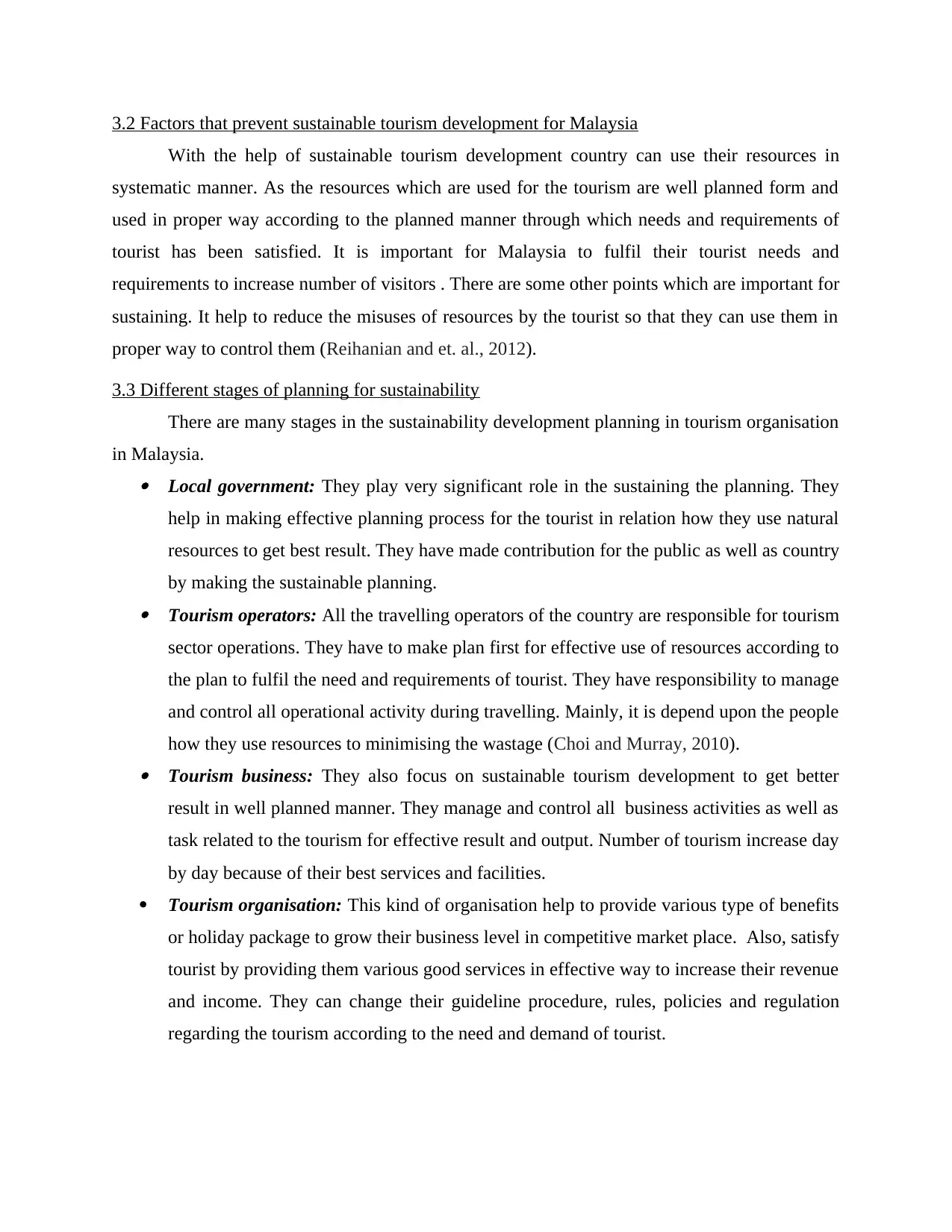
3.2 Factors that prevent sustainable tourism development for Malaysia
With the help of sustainable tourism development country can use their resources in
systematic manner. As the resources which are used for the tourism are well planned form and
used in proper way according to the planned manner through which needs and requirements of
tourist has been satisfied. It is important for Malaysia to fulfil their tourist needs and
requirements to increase number of visitors . There are some other points which are important for
sustaining. It help to reduce the misuses of resources by the tourist so that they can use them in
proper way to control them (Reihanian and et. al., 2012).
3.3 Different stages of planning for sustainability
There are many stages in the sustainability development planning in tourism organisation
in Malaysia. Local government: They play very significant role in the sustaining the planning. They
help in making effective planning process for the tourist in relation how they use natural
resources to get best result. They have made contribution for the public as well as country
by making the sustainable planning. Tourism operators: All the travelling operators of the country are responsible for tourism
sector operations. They have to make plan first for effective use of resources according to
the plan to fulfil the need and requirements of tourist. They have responsibility to manage
and control all operational activity during travelling. Mainly, it is depend upon the people
how they use resources to minimising the wastage (Choi and Murray, 2010). Tourism business: They also focus on sustainable tourism development to get better
result in well planned manner. They manage and control all business activities as well as
task related to the tourism for effective result and output. Number of tourism increase day
by day because of their best services and facilities.
Tourism organisation: This kind of organisation help to provide various type of benefits
or holiday package to grow their business level in competitive market place. Also, satisfy
tourist by providing them various good services in effective way to increase their revenue
and income. They can change their guideline procedure, rules, policies and regulation
regarding the tourism according to the need and demand of tourist.
With the help of sustainable tourism development country can use their resources in
systematic manner. As the resources which are used for the tourism are well planned form and
used in proper way according to the planned manner through which needs and requirements of
tourist has been satisfied. It is important for Malaysia to fulfil their tourist needs and
requirements to increase number of visitors . There are some other points which are important for
sustaining. It help to reduce the misuses of resources by the tourist so that they can use them in
proper way to control them (Reihanian and et. al., 2012).
3.3 Different stages of planning for sustainability
There are many stages in the sustainability development planning in tourism organisation
in Malaysia. Local government: They play very significant role in the sustaining the planning. They
help in making effective planning process for the tourist in relation how they use natural
resources to get best result. They have made contribution for the public as well as country
by making the sustainable planning. Tourism operators: All the travelling operators of the country are responsible for tourism
sector operations. They have to make plan first for effective use of resources according to
the plan to fulfil the need and requirements of tourist. They have responsibility to manage
and control all operational activity during travelling. Mainly, it is depend upon the people
how they use resources to minimising the wastage (Choi and Murray, 2010). Tourism business: They also focus on sustainable tourism development to get better
result in well planned manner. They manage and control all business activities as well as
task related to the tourism for effective result and output. Number of tourism increase day
by day because of their best services and facilities.
Tourism organisation: This kind of organisation help to provide various type of benefits
or holiday package to grow their business level in competitive market place. Also, satisfy
tourist by providing them various good services in effective way to increase their revenue
and income. They can change their guideline procedure, rules, policies and regulation
regarding the tourism according to the need and demand of tourist.
Paraphrase This Document
Need a fresh take? Get an instant paraphrase of this document with our AI Paraphraser
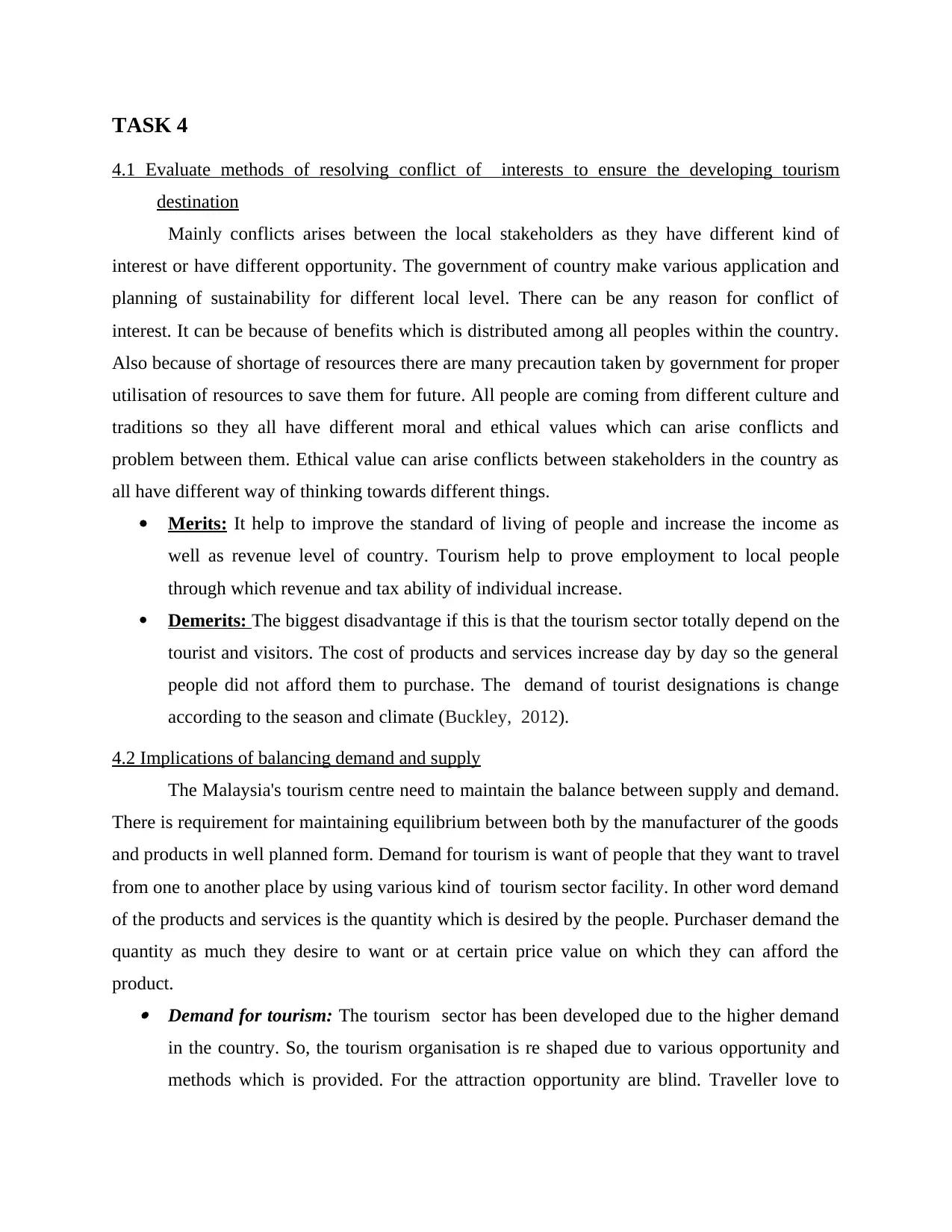
TASK 4
4.1 Evaluate methods of resolving conflict of interests to ensure the developing tourism
destination
Mainly conflicts arises between the local stakeholders as they have different kind of
interest or have different opportunity. The government of country make various application and
planning of sustainability for different local level. There can be any reason for conflict of
interest. It can be because of benefits which is distributed among all peoples within the country.
Also because of shortage of resources there are many precaution taken by government for proper
utilisation of resources to save them for future. All people are coming from different culture and
traditions so they all have different moral and ethical values which can arise conflicts and
problem between them. Ethical value can arise conflicts between stakeholders in the country as
all have different way of thinking towards different things.
Merits: It help to improve the standard of living of people and increase the income as
well as revenue level of country. Tourism help to prove employment to local people
through which revenue and tax ability of individual increase.
Demerits: The biggest disadvantage if this is that the tourism sector totally depend on the
tourist and visitors. The cost of products and services increase day by day so the general
people did not afford them to purchase. The demand of tourist designations is change
according to the season and climate (Buckley, 2012).
4.2 Implications of balancing demand and supply
The Malaysia's tourism centre need to maintain the balance between supply and demand.
There is requirement for maintaining equilibrium between both by the manufacturer of the goods
and products in well planned form. Demand for tourism is want of people that they want to travel
from one to another place by using various kind of tourism sector facility. In other word demand
of the products and services is the quantity which is desired by the people. Purchaser demand the
quantity as much they desire to want or at certain price value on which they can afford the
product. Demand for tourism: The tourism sector has been developed due to the higher demand
in the country. So, the tourism organisation is re shaped due to various opportunity and
methods which is provided. For the attraction opportunity are blind. Traveller love to
4.1 Evaluate methods of resolving conflict of interests to ensure the developing tourism
destination
Mainly conflicts arises between the local stakeholders as they have different kind of
interest or have different opportunity. The government of country make various application and
planning of sustainability for different local level. There can be any reason for conflict of
interest. It can be because of benefits which is distributed among all peoples within the country.
Also because of shortage of resources there are many precaution taken by government for proper
utilisation of resources to save them for future. All people are coming from different culture and
traditions so they all have different moral and ethical values which can arise conflicts and
problem between them. Ethical value can arise conflicts between stakeholders in the country as
all have different way of thinking towards different things.
Merits: It help to improve the standard of living of people and increase the income as
well as revenue level of country. Tourism help to prove employment to local people
through which revenue and tax ability of individual increase.
Demerits: The biggest disadvantage if this is that the tourism sector totally depend on the
tourist and visitors. The cost of products and services increase day by day so the general
people did not afford them to purchase. The demand of tourist designations is change
according to the season and climate (Buckley, 2012).
4.2 Implications of balancing demand and supply
The Malaysia's tourism centre need to maintain the balance between supply and demand.
There is requirement for maintaining equilibrium between both by the manufacturer of the goods
and products in well planned form. Demand for tourism is want of people that they want to travel
from one to another place by using various kind of tourism sector facility. In other word demand
of the products and services is the quantity which is desired by the people. Purchaser demand the
quantity as much they desire to want or at certain price value on which they can afford the
product. Demand for tourism: The tourism sector has been developed due to the higher demand
in the country. So, the tourism organisation is re shaped due to various opportunity and
methods which is provided. For the attraction opportunity are blind. Traveller love to
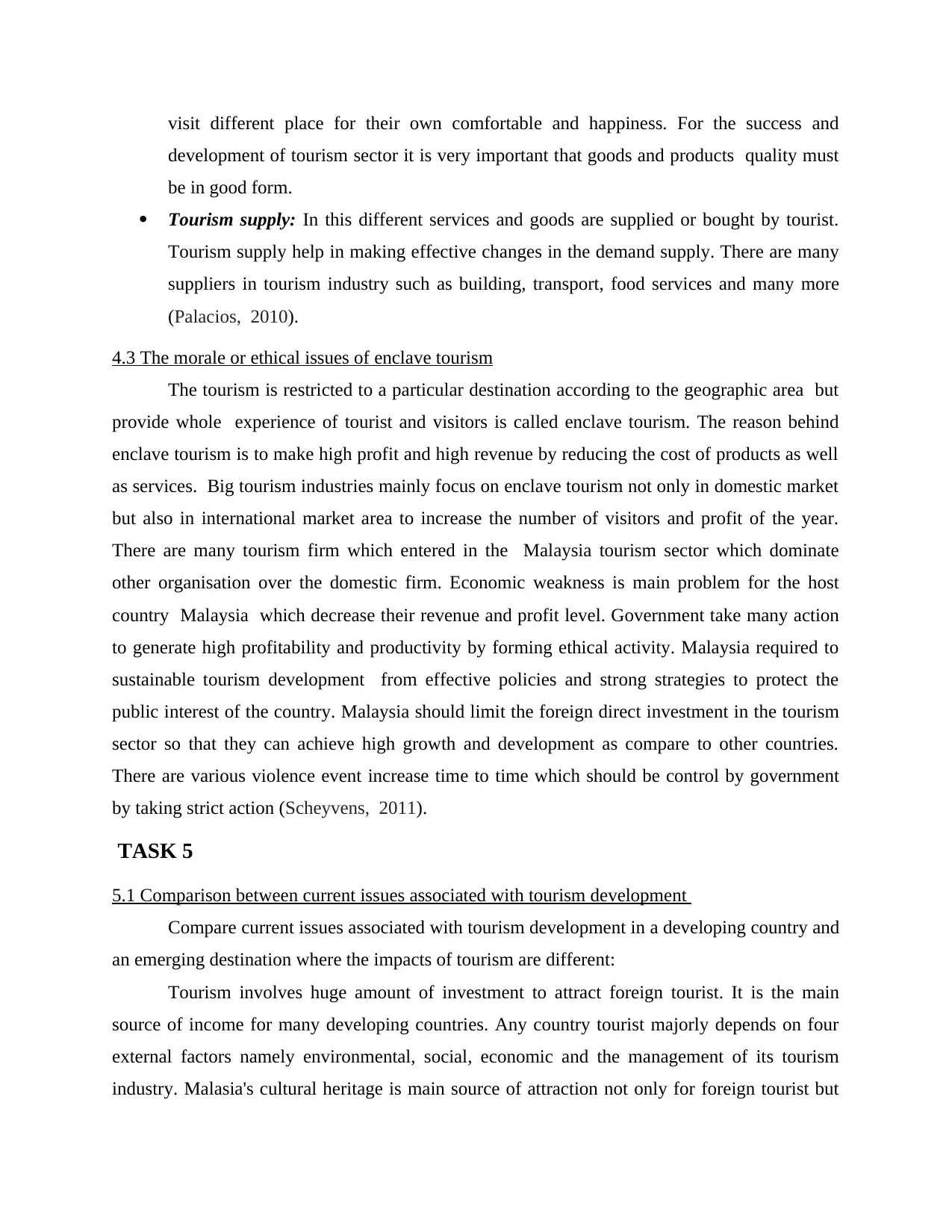
visit different place for their own comfortable and happiness. For the success and
development of tourism sector it is very important that goods and products quality must
be in good form.
Tourism supply: In this different services and goods are supplied or bought by tourist.
Tourism supply help in making effective changes in the demand supply. There are many
suppliers in tourism industry such as building, transport, food services and many more
(Palacios, 2010).
4.3 The morale or ethical issues of enclave tourism
The tourism is restricted to a particular destination according to the geographic area but
provide whole experience of tourist and visitors is called enclave tourism. The reason behind
enclave tourism is to make high profit and high revenue by reducing the cost of products as well
as services. Big tourism industries mainly focus on enclave tourism not only in domestic market
but also in international market area to increase the number of visitors and profit of the year.
There are many tourism firm which entered in the Malaysia tourism sector which dominate
other organisation over the domestic firm. Economic weakness is main problem for the host
country Malaysia which decrease their revenue and profit level. Government take many action
to generate high profitability and productivity by forming ethical activity. Malaysia required to
sustainable tourism development from effective policies and strong strategies to protect the
public interest of the country. Malaysia should limit the foreign direct investment in the tourism
sector so that they can achieve high growth and development as compare to other countries.
There are various violence event increase time to time which should be control by government
by taking strict action (Scheyvens, 2011).
TASK 5
5.1 Comparison between current issues associated with tourism development
Compare current issues associated with tourism development in a developing country and
an emerging destination where the impacts of tourism are different:
Tourism involves huge amount of investment to attract foreign tourist. It is the main
source of income for many developing countries. Any country tourist majorly depends on four
external factors namely environmental, social, economic and the management of its tourism
industry. Malasia's cultural heritage is main source of attraction not only for foreign tourist but
development of tourism sector it is very important that goods and products quality must
be in good form.
Tourism supply: In this different services and goods are supplied or bought by tourist.
Tourism supply help in making effective changes in the demand supply. There are many
suppliers in tourism industry such as building, transport, food services and many more
(Palacios, 2010).
4.3 The morale or ethical issues of enclave tourism
The tourism is restricted to a particular destination according to the geographic area but
provide whole experience of tourist and visitors is called enclave tourism. The reason behind
enclave tourism is to make high profit and high revenue by reducing the cost of products as well
as services. Big tourism industries mainly focus on enclave tourism not only in domestic market
but also in international market area to increase the number of visitors and profit of the year.
There are many tourism firm which entered in the Malaysia tourism sector which dominate
other organisation over the domestic firm. Economic weakness is main problem for the host
country Malaysia which decrease their revenue and profit level. Government take many action
to generate high profitability and productivity by forming ethical activity. Malaysia required to
sustainable tourism development from effective policies and strong strategies to protect the
public interest of the country. Malaysia should limit the foreign direct investment in the tourism
sector so that they can achieve high growth and development as compare to other countries.
There are various violence event increase time to time which should be control by government
by taking strict action (Scheyvens, 2011).
TASK 5
5.1 Comparison between current issues associated with tourism development
Compare current issues associated with tourism development in a developing country and
an emerging destination where the impacts of tourism are different:
Tourism involves huge amount of investment to attract foreign tourist. It is the main
source of income for many developing countries. Any country tourist majorly depends on four
external factors namely environmental, social, economic and the management of its tourism
industry. Malasia's cultural heritage is main source of attraction not only for foreign tourist but
⊘ This is a preview!⊘
Do you want full access?
Subscribe today to unlock all pages.

Trusted by 1+ million students worldwide
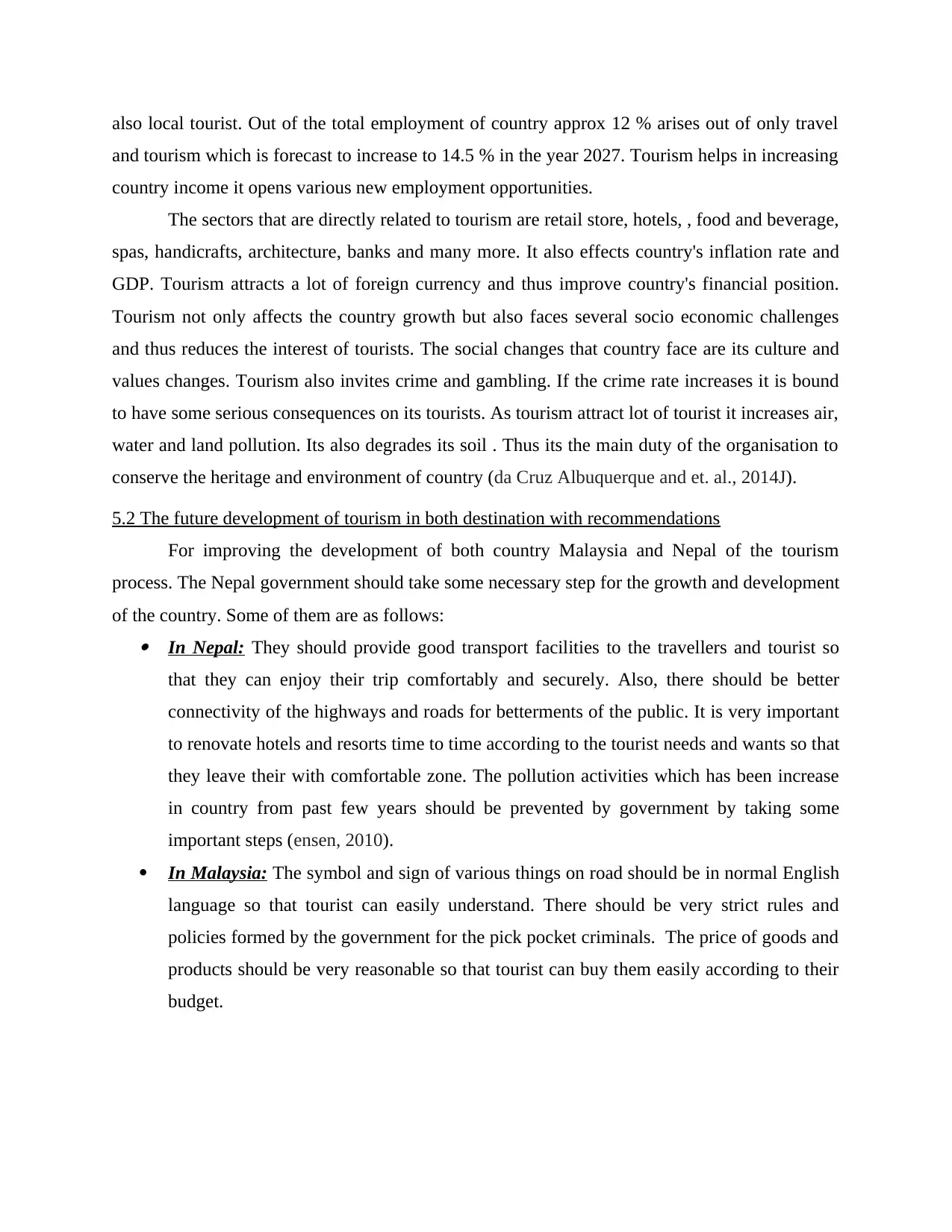
also local tourist. Out of the total employment of country approx 12 % arises out of only travel
and tourism which is forecast to increase to 14.5 % in the year 2027. Tourism helps in increasing
country income it opens various new employment opportunities.
The sectors that are directly related to tourism are retail store, hotels, , food and beverage,
spas, handicrafts, architecture, banks and many more. It also effects country's inflation rate and
GDP. Tourism attracts a lot of foreign currency and thus improve country's financial position.
Tourism not only affects the country growth but also faces several socio economic challenges
and thus reduces the interest of tourists. The social changes that country face are its culture and
values changes. Tourism also invites crime and gambling. If the crime rate increases it is bound
to have some serious consequences on its tourists. As tourism attract lot of tourist it increases air,
water and land pollution. Its also degrades its soil . Thus its the main duty of the organisation to
conserve the heritage and environment of country (da Cruz Albuquerque and et. al., 2014J).
5.2 The future development of tourism in both destination with recommendations
For improving the development of both country Malaysia and Nepal of the tourism
process. The Nepal government should take some necessary step for the growth and development
of the country. Some of them are as follows: In Nepal: They should provide good transport facilities to the travellers and tourist so
that they can enjoy their trip comfortably and securely. Also, there should be better
connectivity of the highways and roads for betterments of the public. It is very important
to renovate hotels and resorts time to time according to the tourist needs and wants so that
they leave their with comfortable zone. The pollution activities which has been increase
in country from past few years should be prevented by government by taking some
important steps (ensen, 2010).
In Malaysia: The symbol and sign of various things on road should be in normal English
language so that tourist can easily understand. There should be very strict rules and
policies formed by the government for the pick pocket criminals. The price of goods and
products should be very reasonable so that tourist can buy them easily according to their
budget.
and tourism which is forecast to increase to 14.5 % in the year 2027. Tourism helps in increasing
country income it opens various new employment opportunities.
The sectors that are directly related to tourism are retail store, hotels, , food and beverage,
spas, handicrafts, architecture, banks and many more. It also effects country's inflation rate and
GDP. Tourism attracts a lot of foreign currency and thus improve country's financial position.
Tourism not only affects the country growth but also faces several socio economic challenges
and thus reduces the interest of tourists. The social changes that country face are its culture and
values changes. Tourism also invites crime and gambling. If the crime rate increases it is bound
to have some serious consequences on its tourists. As tourism attract lot of tourist it increases air,
water and land pollution. Its also degrades its soil . Thus its the main duty of the organisation to
conserve the heritage and environment of country (da Cruz Albuquerque and et. al., 2014J).
5.2 The future development of tourism in both destination with recommendations
For improving the development of both country Malaysia and Nepal of the tourism
process. The Nepal government should take some necessary step for the growth and development
of the country. Some of them are as follows: In Nepal: They should provide good transport facilities to the travellers and tourist so
that they can enjoy their trip comfortably and securely. Also, there should be better
connectivity of the highways and roads for betterments of the public. It is very important
to renovate hotels and resorts time to time according to the tourist needs and wants so that
they leave their with comfortable zone. The pollution activities which has been increase
in country from past few years should be prevented by government by taking some
important steps (ensen, 2010).
In Malaysia: The symbol and sign of various things on road should be in normal English
language so that tourist can easily understand. There should be very strict rules and
policies formed by the government for the pick pocket criminals. The price of goods and
products should be very reasonable so that tourist can buy them easily according to their
budget.
Paraphrase This Document
Need a fresh take? Get an instant paraphrase of this document with our AI Paraphraser
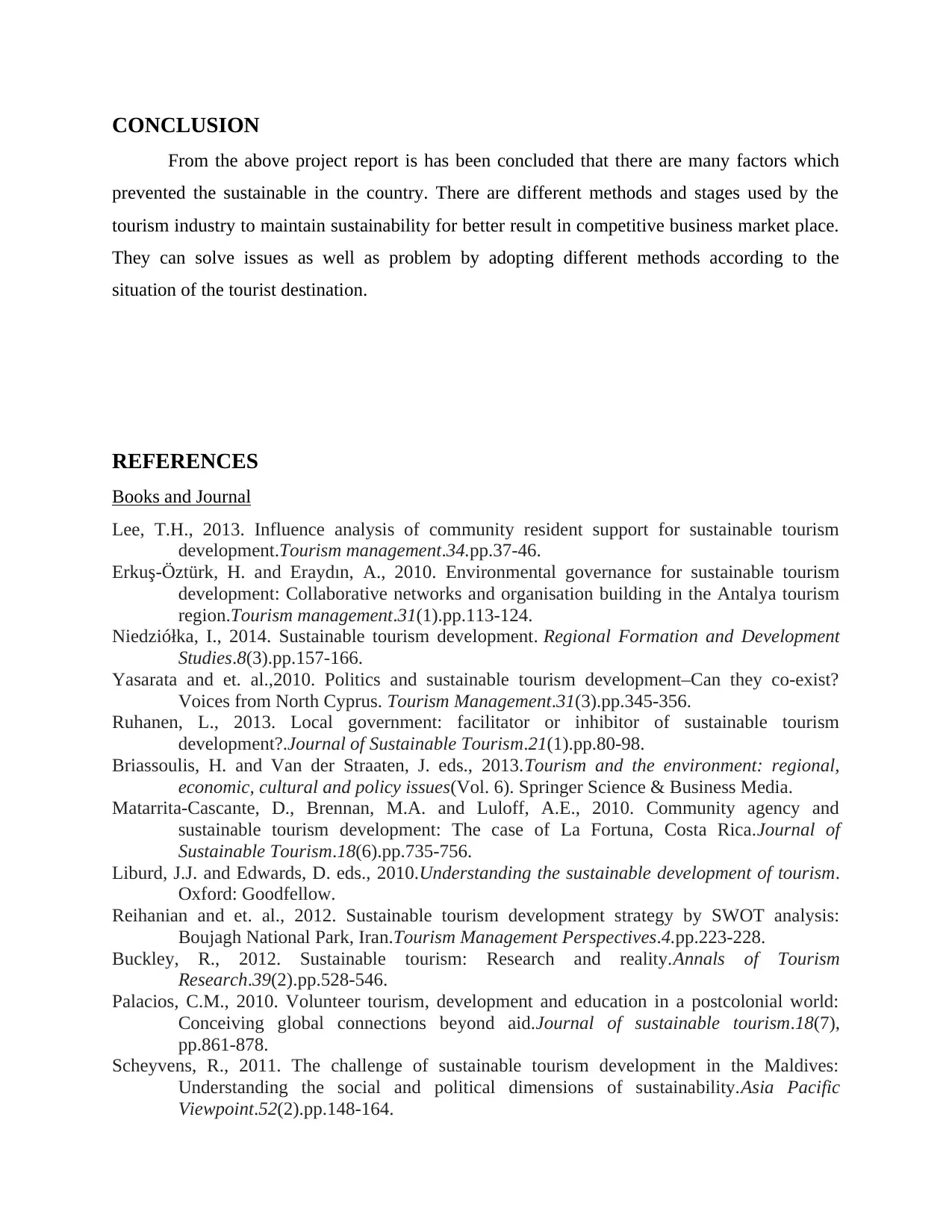
CONCLUSION
From the above project report is has been concluded that there are many factors which
prevented the sustainable in the country. There are different methods and stages used by the
tourism industry to maintain sustainability for better result in competitive business market place.
They can solve issues as well as problem by adopting different methods according to the
situation of the tourist destination.
REFERENCES
Books and Journal
Lee, T.H., 2013. Influence analysis of community resident support for sustainable tourism
development.Tourism management.34.pp.37-46.
Erkuş-Öztürk, H. and Eraydın, A., 2010. Environmental governance for sustainable tourism
development: Collaborative networks and organisation building in the Antalya tourism
region.Tourism management.31(1).pp.113-124.
Niedziółka, I., 2014. Sustainable tourism development. Regional Formation and Development
Studies.8(3).pp.157-166.
Yasarata and et. al.,2010. Politics and sustainable tourism development–Can they co-exist?
Voices from North Cyprus. Tourism Management.31(3).pp.345-356.
Ruhanen, L., 2013. Local government: facilitator or inhibitor of sustainable tourism
development?.Journal of Sustainable Tourism.21(1).pp.80-98.
Briassoulis, H. and Van der Straaten, J. eds., 2013.Tourism and the environment: regional,
economic, cultural and policy issues(Vol. 6). Springer Science & Business Media.
Matarrita-Cascante, D., Brennan, M.A. and Luloff, A.E., 2010. Community agency and
sustainable tourism development: The case of La Fortuna, Costa Rica.Journal of
Sustainable Tourism.18(6).pp.735-756.
Liburd, J.J. and Edwards, D. eds., 2010.Understanding the sustainable development of tourism.
Oxford: Goodfellow.
Reihanian and et. al., 2012. Sustainable tourism development strategy by SWOT analysis:
Boujagh National Park, Iran.Tourism Management Perspectives.4.pp.223-228.
Buckley, R., 2012. Sustainable tourism: Research and reality.Annals of Tourism
Research.39(2).pp.528-546.
Palacios, C.M., 2010. Volunteer tourism, development and education in a postcolonial world:
Conceiving global connections beyond aid.Journal of sustainable tourism.18(7),
pp.861-878.
Scheyvens, R., 2011. The challenge of sustainable tourism development in the Maldives:
Understanding the social and political dimensions of sustainability.Asia Pacific
Viewpoint.52(2).pp.148-164.
From the above project report is has been concluded that there are many factors which
prevented the sustainable in the country. There are different methods and stages used by the
tourism industry to maintain sustainability for better result in competitive business market place.
They can solve issues as well as problem by adopting different methods according to the
situation of the tourist destination.
REFERENCES
Books and Journal
Lee, T.H., 2013. Influence analysis of community resident support for sustainable tourism
development.Tourism management.34.pp.37-46.
Erkuş-Öztürk, H. and Eraydın, A., 2010. Environmental governance for sustainable tourism
development: Collaborative networks and organisation building in the Antalya tourism
region.Tourism management.31(1).pp.113-124.
Niedziółka, I., 2014. Sustainable tourism development. Regional Formation and Development
Studies.8(3).pp.157-166.
Yasarata and et. al.,2010. Politics and sustainable tourism development–Can they co-exist?
Voices from North Cyprus. Tourism Management.31(3).pp.345-356.
Ruhanen, L., 2013. Local government: facilitator or inhibitor of sustainable tourism
development?.Journal of Sustainable Tourism.21(1).pp.80-98.
Briassoulis, H. and Van der Straaten, J. eds., 2013.Tourism and the environment: regional,
economic, cultural and policy issues(Vol. 6). Springer Science & Business Media.
Matarrita-Cascante, D., Brennan, M.A. and Luloff, A.E., 2010. Community agency and
sustainable tourism development: The case of La Fortuna, Costa Rica.Journal of
Sustainable Tourism.18(6).pp.735-756.
Liburd, J.J. and Edwards, D. eds., 2010.Understanding the sustainable development of tourism.
Oxford: Goodfellow.
Reihanian and et. al., 2012. Sustainable tourism development strategy by SWOT analysis:
Boujagh National Park, Iran.Tourism Management Perspectives.4.pp.223-228.
Buckley, R., 2012. Sustainable tourism: Research and reality.Annals of Tourism
Research.39(2).pp.528-546.
Palacios, C.M., 2010. Volunteer tourism, development and education in a postcolonial world:
Conceiving global connections beyond aid.Journal of sustainable tourism.18(7),
pp.861-878.
Scheyvens, R., 2011. The challenge of sustainable tourism development in the Maldives:
Understanding the social and political dimensions of sustainability.Asia Pacific
Viewpoint.52(2).pp.148-164.
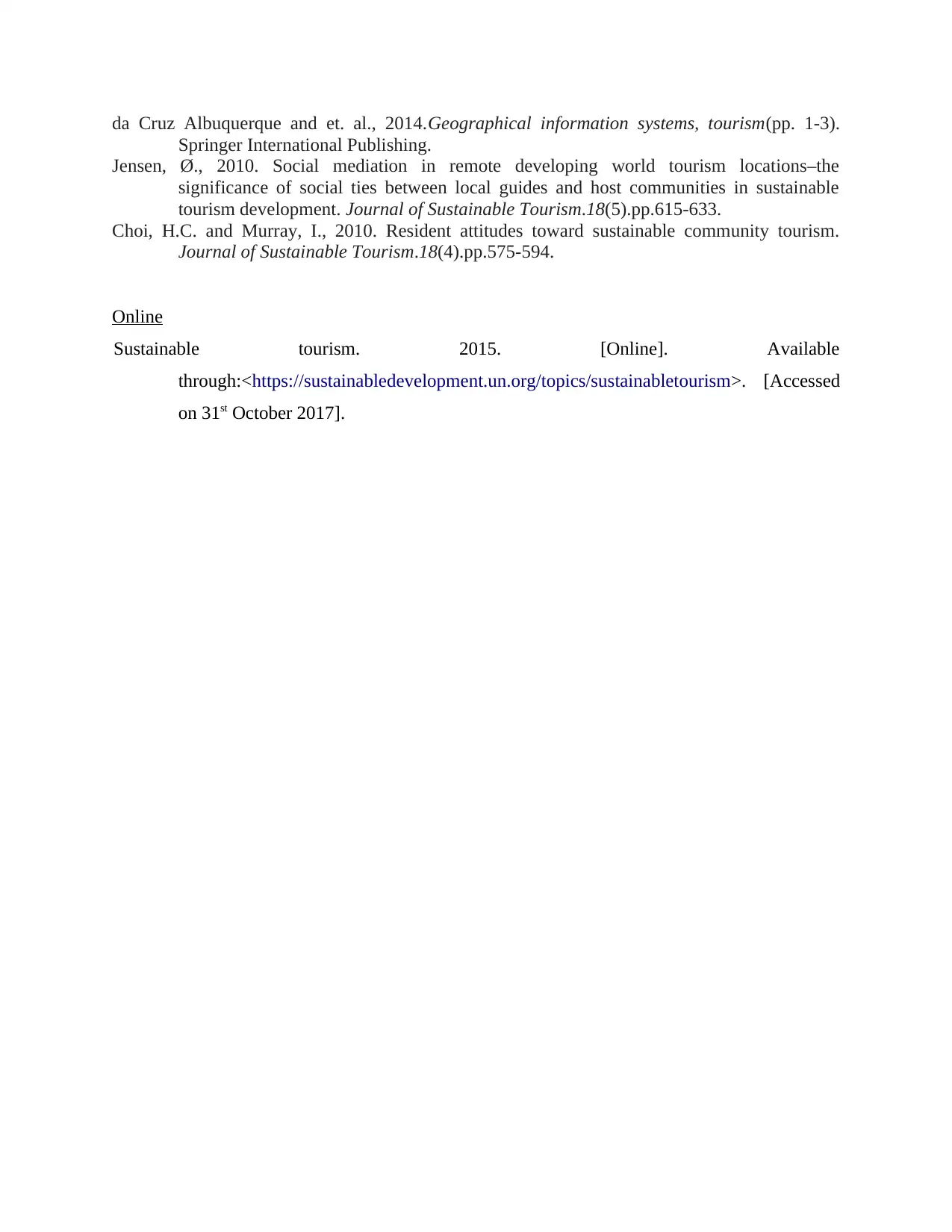
da Cruz Albuquerque and et. al., 2014.Geographical information systems, tourism(pp. 1-3).
Springer International Publishing.
Jensen, Ø., 2010. Social mediation in remote developing world tourism locations–the
significance of social ties between local guides and host communities in sustainable
tourism development. Journal of Sustainable Tourism.18(5).pp.615-633.
Choi, H.C. and Murray, I., 2010. Resident attitudes toward sustainable community tourism.
Journal of Sustainable Tourism.18(4).pp.575-594.
Online
Sustainable tourism. 2015. [Online]. Available
through:<https://sustainabledevelopment.un.org/topics/sustainabletourism>. [Accessed
on 31st October 2017].
Springer International Publishing.
Jensen, Ø., 2010. Social mediation in remote developing world tourism locations–the
significance of social ties between local guides and host communities in sustainable
tourism development. Journal of Sustainable Tourism.18(5).pp.615-633.
Choi, H.C. and Murray, I., 2010. Resident attitudes toward sustainable community tourism.
Journal of Sustainable Tourism.18(4).pp.575-594.
Online
Sustainable tourism. 2015. [Online]. Available
through:<https://sustainabledevelopment.un.org/topics/sustainabletourism>. [Accessed
on 31st October 2017].
⊘ This is a preview!⊘
Do you want full access?
Subscribe today to unlock all pages.

Trusted by 1+ million students worldwide
1 out of 12
Related Documents
Your All-in-One AI-Powered Toolkit for Academic Success.
+13062052269
info@desklib.com
Available 24*7 on WhatsApp / Email
![[object Object]](/_next/static/media/star-bottom.7253800d.svg)
Unlock your academic potential
Copyright © 2020–2025 A2Z Services. All Rights Reserved. Developed and managed by ZUCOL.





